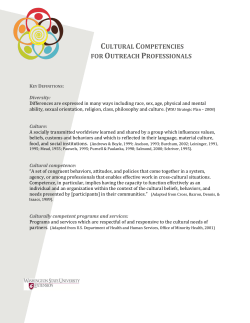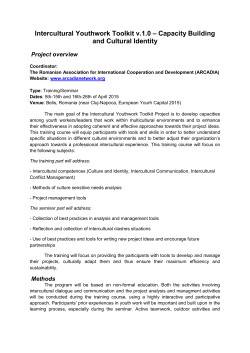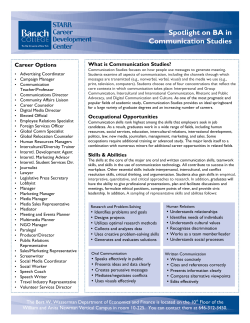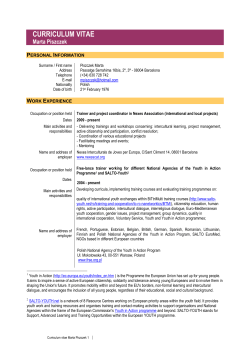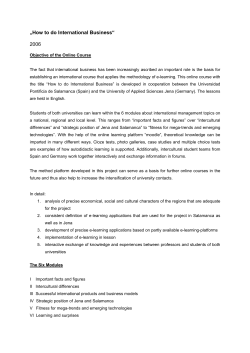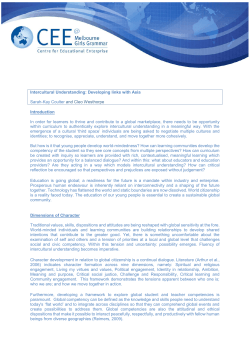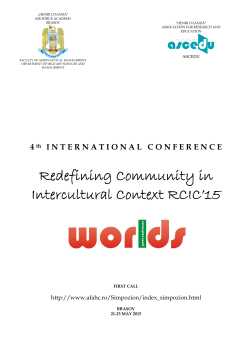
"CulTech2015: Cultural Diversity and Technology
CulTech2015: Cultural Diversity and Technology Design
Helen Ai He,
Nemanja Memarovic
University of Zurich, Switzerland
{helen.he, memarovic}@ifi.uzh.ch
Amalia Sabiescu
Coventry University, UK
amalia.sabiescu@
coventry.ac.uk
ABSTRACT
With globalization and technological advances, people are
increasingly coming into contact with others from different
cultural backgrounds, particularly in place-based and virtual
communities. Yet, cultural diversity – the diversity of
community members’ cultural backgrounds – offers both
significant benefits and challenges in the design, usage and
evaluation of technologies. In this one-day workshop, we
explore the role of cultural diversity in potentially
informing, supporting, challenging or impacting the design
of Information and Communications Technology (ICT)
within community contexts. Our goal is to bring together
experts from different domains such as computer science,
urban design, interactive art, anthropology and social
sciences who share a common interest in exploring the
design space of ICTs, culture and communities.
Author Keywords
Cultural diversity; community-based design; participatory
design; cultural issues in design
ACM Classification Keywords
Human-centered computing: Human computer interaction
(HCI): Interaction paradigms, Interactive systems and tools
INTRODUCTION
With globalization and technological advances, people are
increasingly coming into contact with others from different
cultural backgrounds, particularly in place-based and virtual
communities [6, 21]. Yet, cultural diversity – the diversity
of community members’ cultural backgrounds – can be
both an asset and a liability. On the one hand, studies show
that culturally diverse groups have the potential to
outperform culturally homogeneous groups in problem
solving [22], creativity and performance [13], and are less
predisposed to “groupthink” [13]. On the other hand, since
culture is associated with deep differences in values,
perspectives and cognitive frameworks [8], cultural
diversity contributes to a lack of shared mental models,
which increases the complexity and ambiguity of
Paste the appropriate copyright/license statement here. ACM now
supports three different publication options:
ACM copyright: ACM holds the copyright on the work. This is the
historical approach.
License: The author(s) retain copyright, but ACM receives an
exclusive publication license.
Open Access: The author(s) wish to pay for the work to be open
access. The additional fee must be paid to ACM.
This text field is large enough to hold the appropriate release statement
assuming it is single-spaced in TimesNewRoman 8 point font. Please do
not change or modify the size of this text box.
Aldo de Moor
CommunitySense
Netherlands
ademoor@communitysense.nl
communication [20]. If cultural differences are not
understood or resolved, culturally diverse groups perform
poorly, experience more negative emotions than culturally
homogenous groups [3], as well as lower levels of trust [1]
and cohesion [22].
In the CulTech one-day workshop, we explore the role of
cultural diversity in potentially informing, supporting,
challenging or impacting the design of Information and
Communications Technology (ICT) within community
contexts. To delve into this complex and multi-faceted
space, we welcome workshop submissions that 1) engage
broadly with the role of culture within technology design
and usage for, with and by communities, as well as 2)
proposals for approaches, tools, conceptual and
methodological frameworks, case studies and best practices
in community-based design that exploit cultural diversity as
asset and seek to facilitate intercultural interactions. Our
goal is to bring together experts from different domains
such as computer science, community informatics, urban
design, interactive art, cultural anthropology and social
sciences who share a common interest in exploring the
challenges and opportunities in the design space of ICTs,
culture and communities.
DEFINING CULTURE
Culture is a complex and multidimensional construct [10].
With over 300 definitions and conceptualizations of
“culture” [10], the first challenge is to arrive at an
understanding of what “culture” is. In this workshop, we
refer to a definition of culture as “an accumulated pattern of
values, beliefs, and behaviors shared by an identifiable
group of people with a common history and a verbal and
nonverbal symbol system” [14]. Thus, culture is not innate,
but learned [7], influencing the way people think, feel,
behave, and communicate with others [14].
Culture can be analyzed on several levels, including
continental, national, regional, organizational and
professional [11]. Since the various facets of culture are all
interrelated [7] and intertwined within the technology
design, usage and evaluation processes, workshop
submissions employing diverse definitions and varied
approaches to culture will be considered for acceptance.
BACKGROUND AND RELATED WORK
The design space of ICTs, culture and communities is
informed by a growing and multidisciplinary body of work
that draws upon disciplines such as cultural and media
studies, sociology, anthropology, community development
and more broadly, development studies, computer science
and community informatics. This workshop proposes two
pathways by which this body of work can be examined to
inform design: 1) A broader engagement with and
examination of the role of culture in technology design and
usage, and 2) Practical and action-oriented approaches in
technology design for facilitating intercultural interaction.
The role of culture in technology design and usage
Culture plays a significant role in technology design and
usage. As cultural anthropologist Hall states, “culture is
man’s medium” – the means by which one’s reality is
defined [7]. Consequently, artifacts of culture, such as
information technology, are not designed in a culturally
neutral way, but are rather encoded with the designer’s
implicit (and often subconscious) cultural values [4]. For
example, previous work has shown how culture influences
the encoding and decoding of meanings associated with
representations of daily life, and the importance of
accounting for these differences during technology design
stages [17]. This bespeaks the need to integrate the
perspectives of users in design processes, particularly in
culturally diverse communities. Community participation in
design poses its own challenges, ranging from differences
between the designers’ and community members’
epistemological frames [2] to challenges raised by local
customs and protocols regulating social interaction [18,19]
and diverse understandings of what community
participation in design actually entails [23].
While the design of technology reflects an encoding of the
designers’ implicit cultural values, technology usage
reflects the end user’s decoding from their own cultural
reference frame. As such, culture influences how end users
perceive and use information technology [12].
For
example, Kayan et al. (2006) found culturally different
perceptions in the importance of audio-video chat,
multiparty chat, and emoticons among East Asians, Indians
and North Americans [9]. Reinecke et al. (2013) found
cultural differences in how people schedule and coordinate
events online [16]. Studies such as these indicate that
“users have not converged into a homogeneous subcultural
group with the same behavioral norms across the world, but
that their use of technology considerably differs between
countries” [16]. Since technology adoption is more likely
when end users’ values match the implicit cultural values
embedded in artefacts during the design stage [12], it is
crucial for the research community to better understand the
role culture plays in technology design and usage.
innate skill, but rather a capability that must be learned
through time and experience [5]. Without a conscious
awareness of how another culture is different from one’s
own, cultural differences are no longer perceived as neutral,
but rather negative, where one is “right” and the other is
“wrong” [25]. Consequently, intercultural contact does not
automatically breed mutual understanding, but may actually
widen the gap between groups, as their own identities and
prejudices are strengthened [8]. The challenges raised by
facilitating effective intercultural interaction come with
important design problems and open questions in the goal
to build connected and cohesive communities. One such
question that we aim to explore during the workshop is how
the design of ICTs can better take advantage of the benefits
of cultural diversity while mitigating the challenges.
WORKSHOP THEMES
To stimulate discussion and exploration in the design space
of ICTs, culture, and communities, we welcome initial idea
explorations, as well as ongoing or completed projects
relating (but not exclusive) to the following themes:
The design of technologies to facilitate intercultural
interaction
While one or two decades ago, the challenges of
intercultural interactions were largely constrained within
the expatriate population [15], in today’s interconnected
world, culturally diverse people interact over a wide variety
of media including Face-to-Face (FTF) and over ComputerMediated Communication (CMC) tools (e.g. email,
videoconferencing, online forums, social networks).
However, effective interaction across cultures is not an
Theoretical and reflective engagements with the role of
culture and cultural difference in community-based
(participatory) design and technology appropriation
across cultures
Means (e.g. methods, tools, frameworks) for crosscultural transferability of design and design processes
Methods, tools and frameworks for context modeling
to inform technology design and configuration
Limits of transferability and situated, emergent design
practices in community contexts
Localization and culturally adaptive interfaces
Empirical studies exploring cultural difference in
technology usage and formulating design implications
Metrics, tools, and frameworks for examining cultural
differences in technology usage
Conceptual papers that problematize design, re-framing
design processes from cultural studies and intercultural
communication frameworks (e.g. design as a process of
encoding values and meaning in artefacts)
Uses, benefits and limitations of ethnography and dataintensive research methods in community-based design
Inherent value, tensions and clashes of/between local
and academic/scientific knowledge
Local knowledge management, knowledge conversion
and the challenges posed by structuring fluid
knowledge episodes to generate design requirements
Cultural pathways for community engagement and the
localization of participatory practices
Aligning intentions in multicultural design projects
Bridging differences in culturally diverse design teams
Case studies, approaches and best practices in
community-based design that explore or engage with
issues of connectedness and community cohesion,
facilitating intercultural awareness, communication and
collaboration within communities, and stimulating
intercultural interactions across diverse cultural groups
CONTRIBUTION TYPES
We welcome the following contribution types:
Novel technologies or interaction paradigms
Design or evaluation methods
Case studies on existing applications and systems
Evaluation studies
Theoretical frameworks
Controversial or thought-provoking ideas of issues
relating to communities, culture and ICTs
EXPECTED OUTCOMES
The intended outcomes of this workshop are to:
Identify relevant challenges, barriers, and opportunities
in the design space of ICTs, culture and communities
Propose perspectives on how to address these
challenges in future research and development of
interactive systems
Provide
opportunities
for
networking
and
interdisciplinary collaborations among experts of
different domains
Identify relevant questions to the community moving
forward, and outline a roadmap for future research
Position papers will be published online in Workshop
Proceedings available from the workshop website. Given
the importance of these topic areas for Community
Informatics scholarship, we will also explore the possibility
to publish selected extended papers in a relevant Special
Issue journal.
WORKSHOP ACTIVITIES
We propose a one-day workshop, consisting of 1) an
introduction and cultural diversity exercises, 2)
presentations, 3) group brainstorming in a world café
format [24], 4) lunch and concluding with 5) group
discussion and summarization.
Introduction and cultural diversity games
We will begin with an introduction to the workshop topic
(9:00-9:10), followed by icebreakers and cultural diversity
games aimed at encouraging participants to move beyond
an intellectual understanding of culture to an experiential
awareness and understanding of culture (9:10-9:50).
Examples of exercises include asking participants to enact
cultural behaviors different from their own, e.g. increasing
or decreasing the amount of eye contact and/or
conversational distance when talking, or re-enacting stories
featuring intercultural communication conflicts. A coffee
break will take place between 9:50-10:00.
Presentations
Next, participants will present short introductory
presentations (2-6 minutes, depending on the number of
participants) regarding their research topic and its relevance
towards the workshop themes (10:00-11:00). Depending on
the context of the presentations, the discussion will evolve
dynamically, under the facilitation of the workshop
organizers who will solicit the interactive involvement of
all participants.
Group brainstorming
Following the presentations, we will start a group
brainstorming session in a world café format [24] (11:0012:00). Participants will be asked to move to different
tables, where each table has its own theme (which the
organizers will provide). Each group will brainstorm
around that theme for 20 minutes, after which we will ask
them to switch tables to a different theme. By the end of
this time slot, participants will have had a chance to visit all
the tables and contribute their insights for each theme.
Lunch
Lunch will be scheduled for 12:00-13:30.
Summarizing the group work results
Participants will go back to the last table they were at in the
previous session. All groups will be asked to summarize the
main thoughts from the theme of that table and
communicate it to the workshop group through whatever
creative presentation style they prefer (e.g. scenarios,
acting, role-playing, storyboards) (13:30-14:30). After a
brief coffee break (14:30-14:40), participants will present to
the workshop group, where the organizers will distill
current challenges, opportunities and future research
directions (14:40-15:45). Coffee break from 15:45-16:00.
Group discussion
In the last session of the day (16:00-17:00), the organizers
will summarize key experiences and encourage open
discussion to identify relevant questions in moving forward
and outline a roadmap for future research directions.
MEANS OF SOLICITING PARTICIPATION
Participation will be solicited through multiple venues,
including a workshop website, mailing list advertisements
(e.g., CHI, CSCW, DIS, CABS, Ubicomp), as well as
promotions via Facebook, Twitter and LinkedIn. We will
also contact authors and colleagues who have published on
topics relevant to the workshop themes.
PARTICIPANTS
Workshop candidates are requested to send either a position
paper (min. 2 pages, max. 4 pages in the ACM format) or a
video submission about their research and its relevance to
the workshop themes. The maximum number of workshop
participants is 20, including the workshop organizers.
DEADLINES
Workshop submission deadline: May 1, 2015
Feedback to authors: May 15, 2015
Workshop at C&T 2015: June 27 or 28, 2015
ORGANIZERS
Helen Ai He is a PhD candidate in the Department of
Informatics at the University of Zurich. Her research
explores the intercultural communication challenges
professionals experience in the workplace in both Face-toFace (FTF) and over Computer-Mediated Communication
(CMC) (e.g. email, videoconferencing). Previously, she
worked as a software developer for education tools, and
also conducted research on persuasive technologies to
motivate environmentally sustainable behaviors.
Nemanja Memarovic is the Acting Director of People and
Computing Lab at the Department of Informatics,
University of Zurich. His interests lie between the
intersection of public spaces, situated technologies and
communities. Nemanja was a PC co-chair of the
Community Informatics’12 and ‘13 conference, a coorganizer of the SOFTec workshop at Ubicomp ‘12 and
‘13, HCI3P at DIS’14, PD-Apps at PerCom’14, and
“Personal or Social?” workshop at NordiCHI’14. Also, he
was a publicity and in-situ demo chair of PerDis ‘11 and
‘15, and Web chair for UbiComp ‘13. He is also a PC
member of PerDis since its foundation 2012.
7. Hall, E.T. 1976. Beyond Culture. Anchor Books.
8. Hofstede, G. 2001. Culture’s Consequences. Sage
Publications.
9. Kayan, S., Fussell, S.R., Setlock, L.D. 2006. Cultural
differences in the use of Instant Messaging in Asia and
North America. CSCW, 525-528.
10. Kroeber, A.L., Kluckhohn, C., Untereiner, W., Meyer,
A.G. 1952. Culture: A critical review of concepts and
definitions. New York: Vintage Books.
11. Laroche, L. 2003. Managing cultural diversity in
technical professions. Routledge.
12. Leidner, D.E., Kayworth, T. 2006. Review: A review of
culture in information systems research. MIS Quarterly,
30(2), 357-399.
13. McLeod, P.L., Lobel, S.A. 1992. The effects of ethnic
diversity on idea generation in small groups. Academy of
Management (1).
Amalia Sabiescu is a Senior Research Assistant affiliated
with the Centre for Dance Research at the Coventry
University School of Art and Design. Her research is
situated at the interface between technology, culture and
community development studies, with a special interest in
issues related to agency, empowerment, voice, and
community participation in technology design. Amalia is
maintaining an active record of events organisation and
publications for the community informatics, development
informatics, and participatory design research communities.
14. Neuliep, J.W. 2000. Intercultural communication: A
contextual approach. Houghton Mifflin Company.
Aldo de Moor is owner of the CommunitySense research
consultancy company, founded in 2007. The firm's mission
is to link research and practice in the rapidly advancing
field of Community Informatics, and to translate state-ofthe-art insights into working communities for clients. Aldo
earned his PhD in Information Management from Tilburg
University in the Netherlands in 1999. From 1999-2004, he
was an assistant professor at the Department of Information
Systems and Management at Tilburg University. From
2005-2006, he was a senior researcher at the Semantics
Technology and Applications Research Laboratory
(STARLab) of the Vrije Universiteit Brussel in Belgium.
17. Rodil, K., et al. 2012. Enhancing cross- cultural
participation through creative visual exploration. Proc.
of PDC, 81-90.
REFERENCES
15. Ng, K.Y., Dyne, L.V., Ang, S. 2012. Cultural
intelligence:
A
review,
reflections,
and
recommendations for future research. Conducting
multinational research projects in org. psychology.
16. Reinecke, K, Nguyen, M.K., Bernstein, A., Naef, M.,
Gajos, K.Z. 2013. Doodle around the world. CSCW, 4554.
18. Sabiescu, A.G., David, S., van Zyl, I., Cantoni, L. 2014.
Emerging Spaces in Community-based Participatory
Design: Reflections from Two Case Studies. PDC, 1-10.
19. Sabiescu, A. G., Memarovic, N. 2013. Participatory
Design for Cultural Representation: A Cultural
Transparency Perspective. INTERACT, 611-618.
20. Shachaf, P. 2008. Cultural diversity and information and
communication technology impacts on global virtual
teams: An exploratory study. Info. and Mgmt, 45.
1. Adler, N.J. 2002. International dimensions of
organizational behavior. 4th Edition. Cincinnati, OH.
21. Thompson, C. W. 2002. Urban open space in the 21st
century. Landscape and urban planning, 60(2), 59 – 72.
2. Bidwell, N., Hardy, D. 2009. Dilemmas in situating
participation in rural ways of saying. OZCHI, 145-152.
22. Watson, W.E., Kamalesh, K., Michaelsen, L.K. 1993.
Cultural diversity’s impact on interaction process and
performance. Academy of Mgmt. Journal, 36(3).
3. Chen, L. 1995. Interaction involvement and patterns of
topical talk. Int. J. of Inter. Rel., 19.
4. Coombs, R., Knights, D., Willmott, H, C. 1992. Culture,
control and competition. Organization Science, 51-72.
5. Crowne, K.A. 2008. What leads to cultural intelligence?
Business Horizons, 51(5), 391-399.
6. Gurstein, M. 2007. What is community informatics (and
why does it matter)? Polimetrica sas.
23. Winschiers-Theophilus, H., et al. 2010. Being
participated: a community approach. Proc. PDC, 1-10.
24. World Café. http://www.theworldcafe.com/method.html
25. Zaharna, R. S. 1995. Understanding cultural preferences
of Arab communication patterns. Public Relations
Review, 21(3), 241-255.
© Copyright 2025
